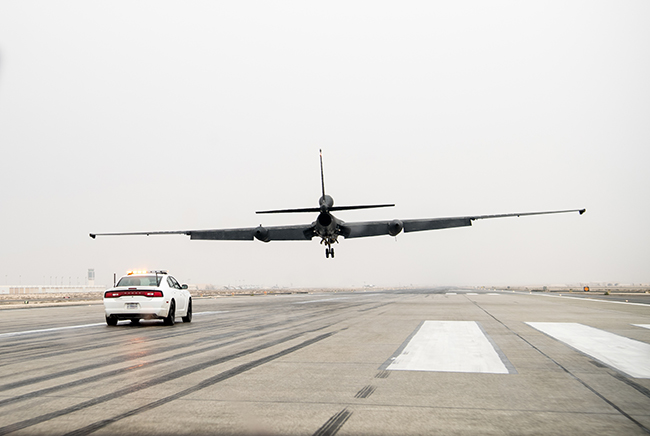
A 99th Expeditionary Reconnaissance Squadron U-2 Dragon Lady pilot drives a high-performance chase car on the runway to catch a U-2 performing a low-flight touch and go at Al Dhafra AB, United Arab Emirates, Mar. 15, 2019. While driving the chase cars, U-2 pilots aid the pilot flying the U-2 by radioing altitude and runway alignments during take-offs and landings. Air Force photo by SrA. Gracie I. Lee.
The US-led coalition is limited in its ability to collect intelligence, surveillance, and reconnaissance in key regions of the Iraq and Syria border as ISIS forces regroup and plan attacks, a Defense Department watchdog says in a new report.
US and coalition aircraft face direct “electromagnetic interference,” maintenance issues, and an overall shortfall in the number off ISR assets available, which in turn has limited the surveillance available to US-backed and Iraqi forces fighting ISIS. ISR is so limited the coalition can only provide ISR targeting support to special operations troops in the area, the Defense Department Inspector General states in its quarterly report on Operation Inherent Resolve.
The interference and lack of assets meant “about 11 percent of coalition ISR coverage this quarter was lost, specifically affecting areas along the Iraq-Syria border and in northern Iraq,” the report states.
Because of the limitations, the OIR Special Operations-Joint Task Force has to request ISR from US Central Command, which operates at higher altitudes, to support their requirements. “The use of these platforms that provide less detail resulted in a greater reliance on human intelligence” and information provided by Iraqi forces, the report states.
Additionally, the Iranian presence in Eastern Iraq limited the coalitions’ ability to fly ISR missions in that area, letting ISIS reconstitute in areas close to the Iraq-Iran border, the report states.
Since US-backed Syrian Democratic Forces on March 23 declared victory over the ISIS caliphate after defeating them in the holdout Syrian city of Baghuz, publicly available reports estimate the number of remaining fighters as somewhere between 14,000 to 30,000, the report states.
The fighters that moved into Iraq have “maintained a low profile” in order to focus on rebuilding the organization’s internal structure, though it has continued a “steady pace” of assassinations, attacks, and bombings, the report states.
The coalition recently “refreshed” an effort, called Operation Reliable Partnership, to help build the capacity of Iraqi Security Forces to conduct anti-ISIS operations. This operation will focus on specific shortfalls that can be addressed by September 2020. However, the coalition reports it will not be able to resolve “at least two major problems” inside the ISF: the lack of ISR and the lack of a “fusion cell” to synchronize and distribute intelligence across its own forces and partner agencies, the report states.
Inside Syria, the report details concerns that ISIS is organizing into “well-supplied” clandestine cells inside large internally displaced persons camps and urban centers in the north and west of the country.
The US military is continuing its drawdown inside Syria, following President Donald Trump’s December announcement that US forces had defeated ISIS inside Syria and would withdraw. That announcement evolved into the February determination that an unspecified “limited” number for troops would remain. The report states “the same core capabilities” would remain with the goal of securing the “enduring defeat” of ISIS.
The announcements brought concern from other US groups. State Department personnel, for example, have said they are concerned about “a lack of security” where their stabilization projects are underway. US Agency for International Development personnel have said they are worried about the impact the withdrawal will have on security and stability, and it already has a “deterioration in relations” with local leadership, the report states.